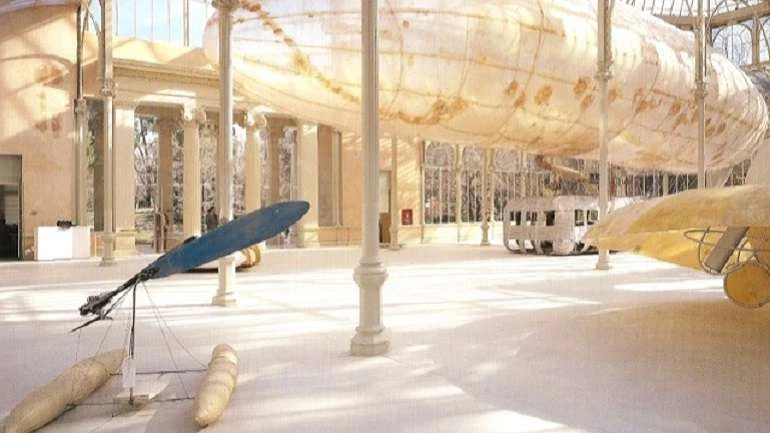Panamarenko

Leonardo da Vinci inevitably echoes from Panamarenko’s aerial constructions whose career begins in the late sixties with performances, happenings and early sculptures influenced by Pop Art. His unlimited capacity for invention soon begins to find inspiration in science. The artist references Belgian astronomer and mathematician Jules Henri Poincaré, the Scottish physicist James Clerk Maxwell and German physicist Ernst Mach, although his greatest influence is writer Alfred Jarry, creator of Pataphysics, the study of imaginary solutions and laws governing exceptions.
The centrepiece of this exhibition is The Aeromodeller (1969-1971), an airship of large dimensions installed in the centre of the Pabellón de Cristal. Panamarenko uses interwoven reed from Palembang for the cabin of the apparatus, PVC transparent sheets for the structure of the globe and four engines, all to construct a piece intended to impress Brigitte Bardot. Big of the Ferro Lusto (1997) is another of his pieces in the exhibition, a seven-metre dish made of gaseous glass. A three-metre area to accommodate passengers can be found inside.
Next to it other machines are exhibited, including: The Monocedo (2000), a precarious helicopter with two floats designed for a water landing; Jungle, Mountain Machine K2 (1991), a flying car which looks like it comes from a science fiction film; Das Flugzeug (1967), a flying machine whose mechanism comes from bicycle parts, The Raven, Variable Matrix (2000), a device with rubber wings that simulates a crow flapping its wings or Flying Carpet (2001), a stainless steel structure in which sixteen propellers are attached with the intention of lifting it to flight.
A shelf displays Panamarenko’s smaller pieces, revealing his interest in robotics that has led him to build automatons such as Persis Lambatta II (2001), a small bird with solar panels on its wings. Despite the scientific basis underlying all his productions, Panamarenko’s intention is not for his machines to work. The exhibition catalogue includes narrations on the making of each piece and the workings of some of them. You can also see pictures of the assemblage at the Palacio de Cristal which, transformed into a hangar, blends in surprisingly well with the Belgian artist's work.
Artists
Organised by
Museo Nacional Centro de Arte Reina Sofía
Image gallery

